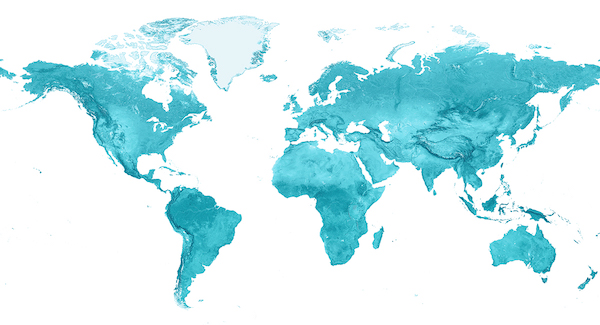
Region of Origin

Commodity:
Dried Chile Peppers
Description & Origin
Chile peppers come in a wide variety of shapes, sizes, colors, flavors, and spice levels. They are differentiated from bell peppers by the presence of capsaicin, a natural chemical compound that is responsible for making them “spicy.” Many thin-walled chile peppers are dried to preserve them after the harvest. In order to be considered dried, the moisture content must be reduced from 65-80% to 8-1...
Health Benefits & Nutrition
Dried chiles are most notable for their capsaicin content. Capsaicin has been studied for its anti-inflammatory properties, ability to stimulate circulation, promotion of metabolism, potential tempering of insulin levels, and ability to increase mucous production in the lungs and nose. While more research is necessary, studies suggest it may be useful in managing colds and flus, diabetes, heart conditions, weight, arthritis, and pain.
Dried and fresh chiles have been used medicinally since ancient time. Mayans used a mixture of honey and chile pepper paste to treat sore throats and laryngitis. In Bolivia, tonsillitis was treated by drinking an extremely spicy juice made of chile peppers. In Mexico, dried red chiles were boiled until soft, and the paste was then applied to swollen glands. It Europe it was believed to promote digestion.
Our Varieties

Dried Chile Ancho
AKA: Chile Colorado, Chile Pasilla Rojo
Description
Ancho chiles (“ancho” meaning wide in Spanish) are dried ripe poblano peppers. They get their name from the broad shoulders that give the peppers its heart-shaped appearance. Ancho chiles are a dark red to deep mahogany color. They are flat, wrinkled and have a broad stem that tapers at the tip. It has smoky, floral notes with an essence of raisin or prune. Ancho are the least spicy of the common dried chiles at 1,000-2,000 SHU.
Variety Tips & Tricks
Ancho chiles can be used anywhere a smoky, fruity flavor and mild heat is desired. They are most often used whole, rehydrated and incorporated into sauces like mole, but they can also be ground into a powder that makes an especially unique addition to chili and stews.
Commercial Availability (Grown for the US Market)

Dried Chile Chipotle Morita
Description
Chipotle chiles are peppers that were smoked during the drying process. They are primarily made with fully ripe, red jalapeños, which are sweet and spicy. This is known as the morita variety. Depending on the chiles used, chipotles vary in color from dull tan to coffee brown to vibrant red. Most common in Mexican cooking, chipotles are uniquely sweet and smoky with overtones of chocolate and tobacco. They have a subtle, but building, heat, with a SHU at 5,000-10,000. Note that there is another variety of chipotle that is harder to find than the morita: the meco, which is made from jalapenos that have been left on the plant until beginning to dry.
Variety Tips & Tricks
While chipotles are often sold rehydrated in adobo sauce (a classic pairing), it is quite easy to recreate from scratch using the whole dried chile. Once reconstituted, chipotles are added to salsa, sauces, chili, stews, soups, and marinades. Chipotle chiles can also be ground into a powder and blended with salt and other spices for a versatile, smoky seasoning.
Commercial Availability (Grown for the US Market)

Dried Chile De Arbol
Description
Chile de árbol are a Mexican pepper with a bright red color that is retained even after drying (they are called chile de árbol when fresh and dried). They are small and thin, only about 2-3 inches long, and are most often sold dried and de-stemmed. They look much like a cayenne pepper, and are just a bit less spicy – but they still pack a bold heat at 15,000-30,000 SHU, six times hotter than the standard jalapeño pepper. In addition to their heat, de árbol peppers bring a pleasant nutty, earthy flavor to any dish.
Variety Tips & Tricks
Crushed chile de árbol are terrific in a classic Mexican red salsa, or any fiery marinade. The pepper’s tiny size makes it easy to infuse into olive oil, alcohol, and other beverages as well. These vibrant peppers are ideal for stringing together to make decorative garlands called ristras.
Commercial Availability (Grown for the US Market)

Dried Chile Guajillo
Description
Guajillo chiles are the dried version of a Mirsaol chile. They are narrow and long with shiny, smooth, reddish-brown walls. Guajillo peppers are an essential part of Mexican cooking. They have a zingy spice with notes of pine and cranberry. The fruity, tangy flavor is often described as sweet with notes of berries and tea. The chiles have a medium spice at 2,500-5,000 SHU.
Variety Tips & Tricks
Guajillo chiles are often paired with ancho, de árbol, or other chiles in Mexican cooking. They give a golden color to soups, salsa, and braising liquids. They are best used when reconstituted and then blended into a paste. The paste is then used in salsas, mole, and marinades.
Commercial Availability (Grown for the US Market)

Dried Chile Mulato
Description
Mulato chiles, like ancho, are a dried poblano pepper. The look much like the wrinkled ancho, but unlike its cousin (which are made from poblanos harvested at the red ripe stage), mulato peppers are made from over-ripe dark brown poblanos. This gives mulato peppers their characteristic dark chocolate-brown color. It also contributes to their rich flavor. Mulato peppers have a flavor profile of cocoa, licorice root, star anise, cherries, and coffee. It’s smoky and sweet flavor makes it a staple in Mexican cooking. It has a moderately low heat at 2,500-3,000 SHU.
Variety Tips & Tricks
Dried mulato peppers are most often reconstituted, destemmed, pureed, and used in sauce. Its sweet, complex flavor makes it a great addition to Mexican moles.
Commercial Availability (Grown for the US Market)

Dried Chile New Mexican
Description
Dried New Mexico chile peppers are made from a ripe hatch-style chile pepper, much like a California or Anaheim chile, but with more heat and complex flavor. They are small and oblong with a somewhat shiny, dark red-brown skin. This classic Southwestern pepper thought to have originated in Mexico has notes of dried cherry and a crisp, clear acidity. It is low on Scoville Heat scale at 800-1,400.
Variety Tips & Tricks
Dried New Mexico chiles are the classic base for a New Mexican salsa rojo for red enchiladas. They are best when rehydrated and blended into a smooth liquid. Their gentle heat allows for other ingredients to shine. These peppers are often used in the Southwest to create beautiful decorative ristras during the late summer and fall.
Commercial Availability (Grown for the US Market)

Dried Chile Pasilla
AKA: Chile Negro, Pasilla Negro
Description
The pasilla chile is the dried version of Mexico’s chilaca pepper, a long and slender pepper that is only sporadically available fresh in the US market. The name pasilla is Spanish for “little raisin,” a nod to their wrinkled texture; dark brown, almost black color; and sweet, raisin-like flavor. They have a subtle smoky heat with notes of dark chocolate and raisin with earthy, herbaceous undertones. Pasilla chiles have a mild heat, ranging between 1,000 and 2,000 SHU.
Variety Tips & Tricks
Pasilla chiles are essential in Mexican cooking and are often paired with other chiles like ancho or mulato and guajillo. They are used in many regional versions of mole and other salsas. Their thick walls and mild, complex spice make the pasilla well suited to use in creamy sauces.
Commercial Availability (Grown for the US Market)

Dried Chile Puya
AKA: Pulla Chile
Description
Dried puya chiles are a Mexican chile with a smooth, deep red exterior thought to be related to the guajillo. The chiles are several inches long with a clean tapered end. It resembles the guajillo but with more heat. Along with its heat, puya chiles are known for their fruity flavor and mild notes of licorice. The heat ranges from 5,000 to 8,000 SHU.
Variety Tips & Tricks
Puya peppers are a versatile pepper most common in Mexican cuisine, but they are often used in Thai and Chinese cuisine throughout the US as a substitute for harder-to-find Asian varieties. They are most often rehydrated and added to sauces or pastes, although they can also be ground into flakes or powder.
Commercial Availability (Grown for the US Market)
Foodservice Tips
Traditional Culinary Uses
Dried chiles are used to enhance cuisine around the world, whether whole, flaked, and powdered. Each variety offers a different flavor profile, from earthy and smoky to sweet and fiery. In Central and South America, where they originated, they are used in many sauces and pastes, including the iconic Mexican dish, mole. They are also reconstituted and incorporated into pastes or sauces, such as adobo, which can be added to broths, masa, braising liquids, marinades, etc. for a complex spicy and smoky flavor. In Thailand and other areas of Southeast Asia, dried chiles are essential in many curry pastes. In Korea, dried chile powder and flakes are key to the national treasure, kimchi. In Europe, red chile flakes have become a staple condiment for many Italian dishes.
Flavor Pairings
Cabbage, Tomato, Tomatillo, Cilantro, Onion, Scallion, Garlic, Lemongrass, Ginger, Chocolate, Pasta, Rice, Chicken, Beef, Pork, Seafood
How to Prepare
Dried chiles can be used whole or ground into a spice as flakes or powder. Before using, most dried chiles should be washed or wiped clean to remove any dust or dirt. Before processing, dried chiles are often toasted in a dry skillet or under a broiler for a few seconds to release oils and enhance the aroma. To reconstitute whole chiles, immerse the chiles in water or stock until soft (about 30 minutes in cold water or just a few in warm water). Remove the chiles and destem them (seeds and pith can be removed if a less spicy product is desired). Finely chop or puree the chile walls and/or seeds. Both the chile walls and rehydrating liquid can be used to enhance sauces, soups, and pastes. To achieve a smoother sauce, strain. To produce chile flakes or powder, destem the chile (and deseed, if desired) and use a mortar and pestle, grinder, or blender to process. Chile flakes and powder taste their best when made just prior to use.
How to Store in the Kitchen
Dried chiles are a sturdy ingredient with a long shelf life. They keep the best if stored in a dry, dark area at steady room temperature. Store in a container or bag with ventilation to prevent moisture build up. Avoid exposure to changes in temperature; especially exposure to cold, which can create condensation on the peppers that may lead to mold when they are returned to warmer areas. When chile peppers dry out entirely and snap, rather than fold, when bent, it is time to replace with fresh product.
Fight Food Waste Tips for root to stem cooking
Aside from the stem, the entire chile pepper is edible! Use the seeds to increase spiciness. If the water used to reconstitute chiles is not too bitter, it can be incorporated into moles, adobes, and salsas.
Warehouse Storage & Handling
Maintain these conditions for optimal short-term storage shelf life.*
IDEAL STORAGE TEMP:
55-60°F
TEMP STORAGE ZONE:
55-60°F (Warm Storage)
SUBJECT TO CHILLING INJURY:
No
RELATIVE HUMIDITY:
Less than 60%
PRODUCES ETHYLENE:
No
SENSITIVE TO ETHYLENE:
No
Quality Assessment
Look for dry chiles with no condensation in the storage containers or visible mold or moisture on the peppers. Chile peppers should be dry, but not hardened, with some moisture retained. Pods should be pliable when folded, rather than snap. Some size irregularities and misshapen peppers are normal and a product of the production process.
Important Handling Notes
It is of the utmost importance that dried peppers be kept stable and dry. Keep dried chiles at a constant temperature to avoid condensation formation and ensure product is stored in a well-ventilated area away from direct sunlight.
Optimum Shelf Life
Depending on variety, conditions at harvest, and handling, dried chile peppers may last up to 2 years, but are best within 6 months.


